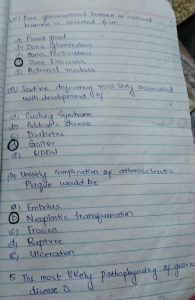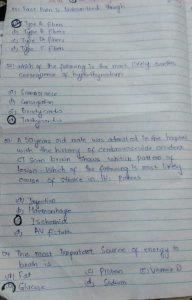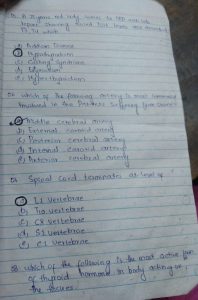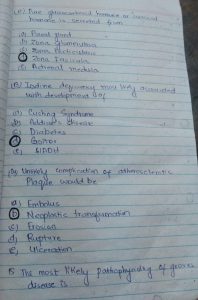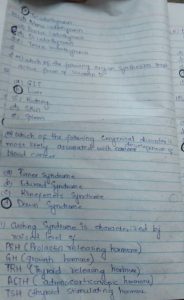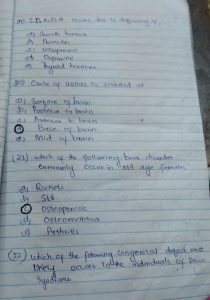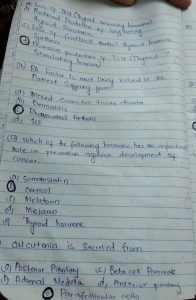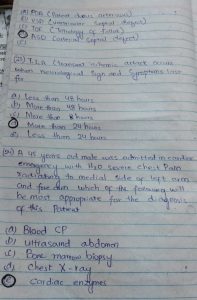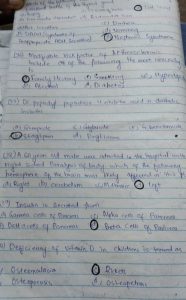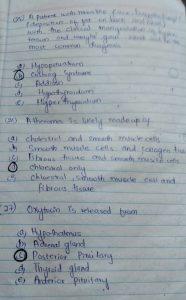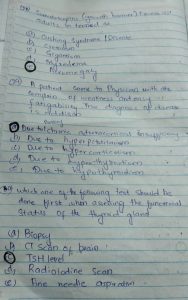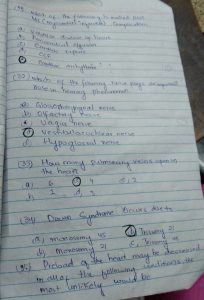1. During khilafat movement an excited mob set fire to a police station at chauri chaura village where about 22 policemen burnt alive in:
a. February 1922
b. February 1923
c. February 1920
d. February 1921
e. February 1924
2. Who presented the resolution for the formation of All India Muslim League:
a. Nawab Salimullah Khan
b. M. Ali Johar
c. Waqar-ul-Mulk
d. Mohsin-ul-Mulk
e. Sir Agha Khan
3. Which of the following was commonly known as the ’Father of idea of Pakistan’?
a. Sir Muhammad Shafi
b. Choudhary Rehmat Ali
c. M A Jinnah
d. Allama Iqbal
4. When India cut off Pakistan’s water supply without notice?
a. June 1948
b. April 1949
c. May 1948
d. May 1949
e. April 1948
5. Mahmood Ghaznavi who ruled Ghani from 997-1030 A.D. raided India for:
a. 17 times
b. 15 times
c. 16 times
d. 19 times
e. 18 times
6. Historical wars of Paniput are very famous ; this battle field is located in Indian Punjab. How many major wars were fought in this field?
a. Five
b. Six
c. Four
d. Three
e. Two
7. The 3rd June plan was announced on 3rd June by:
a. Lord Mounbatten
b. Jawahar Lal Nehru
c. Loord Wavell
d. Moti Lal Nehru
e. M.A. Jinnah
8. Quaid-e-Azam inaugurated the State Bank of Pakistan on:
a. 14th August, 1948
b. 1st July, 1949
c. 14th July, 1948
d. 1st July, 1948
e. 1st June, 1948
9. Who was the chairman of two boundary commissions between India and Pakistan?
a. Sir Cyril Radcliff
b. Tej sinjh
c. Muhammad Muneer
d. Din Muhammad
e. Mehar Chand
10. Name the Viceroy of India who made an offer in August 1940, on the behalf of British Government to Indian people:
a. Lord Wavel
b. Lord Mount Batten
c. Lord Irwin
d. Lord Linlithgow
e. Lord Hardinge
11. Who was appointed as the caretaker prime minister of Pakistan after the first dismissal of Benazeer Bhutto:
a. Aftab Ahmed Sherpao
b. Muhammad Khan Junejo
c. Moen Qureshi
d. Meraj Khalid
e. Ghulam Mustafa Jatoi
12. The Muslims of Sub-continent launched the Khilafat movement in the year of:
a. 1918
b. 1919
c. 1916
d. 1917
e. 1920
13. Which of the following was the first Muslim of India who placed Two Nation Theory?
a. Sir Syed Ahmed Khan
b. Sir Agha Khan
c. M. Ali Jinnah
d. M. Ali Johar
e. Sir Muhammad Shafi
14. Quaid-e-Azam Muhammad Ali Jinnah joined All India Muslim League in the year of:
a. 1913
b. 1915
c. 1914
d. 1912
e. 1916
15. All India Muslim League was established in:
a. September 1905
b. December 1906
c. September 1906
d. December 1907
e. December 1905
16. The Mughal emperor who promulgated a new faith entitled Din-e-Elahi in 1581 A.D. was:
a. Akber
b. Jahangir
c. Humayun
d. Baber
e. Aurangzeb
17. Who was the first prime minister of Pakistan?
a. Kwaja Nazim-ud-din
b. M. Ali Jinnah
c. Liaquat Ali Khan
d. Muhammad Ali Bogra
e. Nur-ul-Amin
18. The Muslim Deputation met the Viceroy Minto in 1906 at:
a. Bombay
b. Delhi
c. Simla
d. Calcutta
e. Lahore
19. Who was the founder of Mughal dynasty?
a. Sher Shah
b. Humayun
c. Akber
d. Jahangir
e. Zaheer-ud-din Baber
20. In 712 A.D a Muslim expedition to conquer Sindh was sent by Hajjaj Bin Yousuf who was:
a. Governer of Iraq
b. Governer of Makran
c. Emperor of Egypt
d. King of Persia
e. Governer of Syria
21. The Simla Deputation led by Agha Khan was consisted of:
a. 25 members
b. 35 members
c. 30 members
d. 32 members
e. 40 members
22. When 3rd Martial law was imposed?
a. 5th July, 1980
b. 5th July, 1978
c. 5th July, 1976
d. 5th July, 1979
e. 5th July, 1977
23. Who coined the name Pakistan?
a. Maulana Muhammad Ali Johar
b. Choudhary Khaliq-uz-zama
c. M,A. Jinnah
d. Choudhary Rehmat Ali
e. Allama Iqbal
24. Select correct chronological order:
a. Akber, Shah Jahan, Humayun, Jahangir
b. Shah Jahan, Jahangir, Akber, Humayun
c. Akber, Humayun, Jahangir, Shah Jahan
d. Jahangir, Shah Jahan, Humayun, Akber
e. Humayun, Akber, Jahangir, Shah Jahan
25. On 23rd March, 1940, the famous resolution which came to be known as Pakistan Resolution was moved by:
a. Choudhary Khaliq-uz-zama
b. Moulvi Fazal-ul-Haq
c. Sardar Auranzeb
d. Moulana Zafar Ali Khan
e. M.Ali Johar
26. Sindh Provincial Muslim League Conference was held at Karachi and passed a resolution adopting Two-Nation Theory on:
a. 10th October, 1938
b. 10th October, 1941
c. 10th October, 1937
d. 10th October, 1939
e. 10th October, 1940
27. The British Government appointed Simon Commission for the recommendation for the new constitution in the year of:
a. 1928
b. 1926
c. 1927
d. 1930
e. 1929
28. The largest political forum of the Islamic countries in the world is:
a. NAM
b. Gulf Countries
c. OIC
d. ECO
e. Arab League
29. With the resignation of Congress Ministries, the Quaid-e-Azam appealed to the people to observe Day of Deliverance on:
a. 22 December, 1938
b. 22 January, 1940
c. 22 January, 1939
d. 22 December, 1939
e. 22 December, 1940
30. Under the Vidya Mandir scheme, the students were asked to pay respect and homage to Gandhi’s picture every day in their assemblies in the schools. The author of this scheme was.
a. Gandhi
b. Imam Ali
c. Zakir Hussain
d. Nehru
e. Dr. Abdul Kalam
31. Name the historians who visited India in 1001 A.D. gave earliest account of distinction between the Hindus and Muslims:
a. Mahmood Ghaznavi
b. Al-Beruni
c. Subuktigin
d. Shahabuddin
e. Alptigin
32. The Indian National Congress passed the ‘Quit India Resolution’ in Bombay on:
a. 30th August, 1942
b. 31st August, 1942
c. 28th August, 1942
d. 18th August, 1942
e. 8th August, 1942
33. Where Quaid-e-Azam taken to in the last months of his life:
a. Ziarat
b. Muree
c. Rawalpindi
d. Quetta
e. Lahore
34. India exploded five nuclear tests on 11th and 13th May 1998. Pakistan replied with atomic explosions on:
a. 27th May, 1998
b. 28th May, 1998
c. 26th May, 1998
d. 25th May, 1998
e. 24th May, 1998
35. The Quran and Sunnah declared as the supreme law of Pakistan in________ of constitution of 1973.
a. 9th amendment
b. 10th amendment
c. 7th amendment
d. 8th amendment
e. 11th amendment
36. Kashmir is located in the ¬¬¬¬¬¬¬¬¬¬¬¬¬¬¬¬¬¬________ of Pakistan.
a. East
b. North East
c. North
d. West
e. South
37. When East Pakistan separated from Pakistan?
a. 8th December, 1971
b. 18th December, 1971
c. 10th December, 1971
d. 16th December, 1971
e. 20th December, 1971
38. The famous Congress-League Scheme was signed in Lucknow in the year of:
a. 1916
b. 1912
c. 1914
d. 1919
e. 1918
39. Which significant step of Bhutto Government in 1974 was a great satisfaction for religious parties?
a. Qadianis were declared as non-Muslims
b. Friday was declared weekly holiday
c. Pakistan was declared Islamic state
d. Separate Electorate were announced
Answer key:
1. A
2. A
3. B
4. E
5. A
6. D
7. A
8. D
9. A
10. D
11. E
12. B
13. A
14. A
15. B
16. A
17. C
18. C
19. E
20. A
21. B
22. E
23. D
24. E
25. B
26. A
27. C
28. C
29. D
30. C
31. B
32. E
33. A
34. B
35. A
36. C
37. D
38. A
39. A

